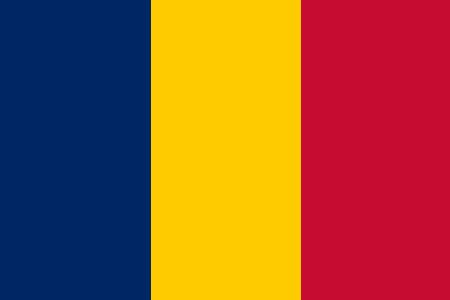Population 12.83 million (2013) GNI per capita 2,010 PPP dollars (2013) Official languages French, Arabic | Life expectancy 50.70 years (2012) Population growth rate 3.0% annual change (2013) | |
 | ||
Fertility rate 6.38 births per woman (2012) | ||
The people of Chad speak more than 100 different languages and divide themselves into many ethnic groups. However, language and ethnicity are not the same. Moreover, neither element can be tied to a particular physical type.
Contents
- Map of Chad
- Population
- Vital statistics
- Fertility and Births
- Religions
- CIA World Factbook demographic statistics
- Median age
- Population growth rate
- Net migration rate
- Sex ratio
- Life expectancy at birth
- HIVAIDS
- Major infectious diseases
- Nationality
- Ethnic groups
- Languages
- Literacy
- References
Map of Chad
Although the possession of a common language shows that its speakers have lived together and have a common history, peoples also change languages. This is particularly so in Chad, where the openness of the terrain, marginal rainfall, frequent drought and famine, and low population densities have encouraged physical and linguistic mobility. Slave raids among{specify} non-Muslim peoples, internal slave trade, and exports of captives northward from the ninth to the twentieth centuries also have resulted in language changes.
Anthropologists view ethnicity as being more than genetics. Like language, ethnicity implies a shared heritage, partly economic, where people of the same ethnic group may share a livelihood, and partly social, taking the form of shared ways of doing things and organizing relations among individuals and groups. Ethnicity also involves a cultural component made up of shared values and a common worldview. Like language, ethnicity is not immutable. Shared ways of doing things change over time and alter a group's perception of its own identity.
Not only do the social aspects of ethnic identity change but the biological composition (or gene pool) also may change over time. Although most ethnic groups emphasize intermarriage, people are often proscribed from seeking partners among close relatives—a prohibition that promotes biological variation. In all groups, the departure of some individuals or groups and the integration of others also changes the biological component.
The Chadian government has avoided official recognition of ethnicity. With the exception of a few surveys conducted shortly after independence, little data were available on this important aspect of Chadian society. Nonetheless, ethnic identity was a significant component of life in Chad.
Chad's languages fall into ten major groups, each of which belongs to either the Nilo-Saharan, Afro-Asiatic, or Niger–Congo language family. These represent three of the four major language families in Africa; only the Khoisan languages of southern Africa are not represented. The presence of such different languages suggests that the Lake Chad Basin may have been an important point of dispersal in ancient times.
Population
According to the 2010 revision of the World Population Prospects the total population was 11 227 000 in 2010, compared to only 2 429 000 in 1950. The proportion of children below the age of 15 in 2010 was 45.4%, 51.7% was between 15 and 65 years of age, while 2.9% was 65 years or older .
Vital statistics
Registration of vital events is in Chad not complete. The Population Departement of the United Nations prepared the following estimates.
Fertility and Births
Total Fertility Rate (TFR) (Wanted Fertility Rate) and Crude Birth Rate (CBR):
Fertility data as of 2014-2015 (DHS Program):
Religions
The separation of religion from social structure in Chad represents a false dichotomy, for they are perceived as two sides of the same coin. Three religious traditions coexist in Chad- classical African religions, Islam, and Christianity. None is monolithic. The first tradition includes a variety of ancestor and/or place-oriented religions whose expression is highly specific. Islam, although characterized by an orthodox set of beliefs and observances, also is expressed in diverse ways. Christianity arrived in Chad much more recently with the arrival of Europeans. Its followers are divided into Roman Catholics and Protestants (including several denominations); as with Chadian Islam, Chadian Christianity retains aspects of pre-Christian religious belief.
The number of followers of each tradition in Chad is unknown. Estimates made in 1962 suggested that 35 percent of Chadians practiced classical African religions, 55 percent were Muslims, and 10 percent were Christians. In the 1970s and 1980s, this distribution undoubtedly changed. Observers report that Islam has spread among the Hajerai and among other non-Muslim populations of the Saharan and sahelian zones. However, the proportion of Muslims may have fallen because the birthrate among the followers of traditional religions and Christians in southern Chad is thought to be higher than that among Muslims. In addition, the upheavals since the mid-1970s have resulted in the departure of some missionaries; whether or not Chadian Christians have been numerous enough and organized enough to have attracted more converts since that time is unknown.
CIA World Factbook demographic statistics
The following demographic statistics are from the CIA World Factbook, unless otherwise indicated.
Population
10,543,000 (2010, According to the U.S. Census Bureau, International Data Base: Demographics of Chad)
Median age
Total: 16.8 yearsMale: 15.6 yearsFemale: 17.9 years (2011 est.)Population growth rate
2.009% (2011 est.)Net migration rate
-3.84 migrant(s)/1,000 population (2011 est.)Sex ratio
At birth: 1.04 male(s)/femaleUnder 15 years: 1.01 male(s)/female15–64 years: 0.92 male(s)/female65 years and over: 0.66 male(s)/femaleTotal population: 0.96 male(s)/female (2006 est.)Life expectancy at birth
Total population: 48.33 yearsMale: 47.28 yearsFemale: 49.43 years (2011 est.)HIV/AIDS
Adult prevalence rate: 4.8% (2003 est.)People living with HIV/AIDS: 200,000(2003 est.)Deaths: 18,000 (2003 est.)Major infectious diseases
Degree of risk: very highFood or waterborne diseases: bacterial and protozoal diarrhea, hepatitis A, and typhoid feverVectorborne disease: malariaWater contact disease: schistosomiasisRespiratory disease: meningococcal meningitis (2005)Nationality
Noun: Chadian(s)Adjective: ChadianEthnic groups
200 distinct groupsAbout 5,000 French citizens live in Chad.
